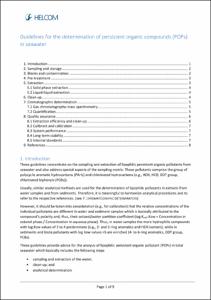| dc.coverage.spatial | Baltic Sea | en_US |
| dc.date.accessioned | 2022-07-12T21:00:46Z | |
| dc.date.available | 2022-07-12T21:00:46Z | |
| dc.date.issued | 2017 | |
| dc.identifier.citation | HELCOM (2017) Guidelines for the determination of persistent organic compounds (POPs) in seawater. Helsinki, Finland, HELCOM, 9pp. DOI: http://dx.doi.org/10.25607/OBP-1796 | en_US |
| dc.identifier.uri | https://repository.oceanbestpractices.org/handle/11329/2001 | |
| dc.identifier.uri | http://dx.doi.org/10.25607/OBP-1796 | |
| dc.description.abstract | These guidelines concentrate on the sampling and extraction of lipophilic persistent organic pollutants from seawater and also address special aspects of the sampling matrix. Those pollutants comprise the group of polycyclic aromatic hydrocarbons (PAHs) and chlorinated hydrocarbons (e.g., HCH, HCB, DDT group, chlorinated biphenyls (PCBs)).
Usually, similar analytical methods are used for the determination of lipophilic pollutants in extracts from water samples and from sediments. Therefore, it is meaningful to harmonize analytical procedures and to refer to the respective references. (see 7. CHROMATOGRAPHIC DETERMINATION)
However, it should be taken into consideration (e.g., for calibration) that the relative concentrations of the individual pollutants are different in water and sediment samples which is basically attributed to the compound’s polarity and, thus, their octanol/water partition coefficient (log Kow; Kow = Concentration in octanol phase / Concentration in aqueous phase). Thus, in water samples the more hydrophilic compounds with log Kow values of 3 to 4 predominate (e.g., 2- and 3-ring aromatics and HCH isomers), while in sediments and biota pollutants with log Kow values >5 are enriched (4- to 6-ring aromatics, DDT group, PCBs).
These guidelines provide advice for the analysis of lipophilic persistent organic pollutant (POPs) in total seawater which basically includes the following steps:
• sampling and extraction of the water;
• clean-up; and
• analytical determination.
The extraction of the POPs simultaneously enables enrichment of the analytes which is a crucial step in the procedure as the expected concentrations in seawater are often only in the pg l-1 range. Extraction and enrichment are usually conducted through solid phase extraction (SPE) or liquid-liquid extraction (LLE).
Determination depends on the chemical structure of the compounds. PAHs can be separated by high performance liquid chromatography (HPLC) with fluorescence detection or gas chromatographic (GC) separation with flame ionization (FID) or mass spectrometric (MS) detection (Fetzer and Vo-Dinh, 1989; Wise et al., 1995). Chlorinated hydrocarbons are generally analysed by gas chromatographic (GC) separation with mass spectrometric (MS) detection.
All steps of the procedure are susceptible to insufficient recovery and contamination. Therefore, regular quality control measures must be applied to monitor method performance. These guidelines are intended to encourage and assist analytical chemists to critically reconsider and improve established methods and associated quality control measures, where necessary.
These guidelines are not intended as complete laboratory manual. If necessary, guidance should be sought from specialized laboratories. Laboratories should demonstrate validity of each methodological step. Moreover, use of an alternative method, carried out concurrently to the routine procedure, is recommended for validation. The participation in analytical proficiency tests is also highly recommended.
Contracting parties should follow the HELCOM monitoring guideline but minor deviations from this are acceptable if the method achieves comparable results. Validation of the adopted method needs to be performed on the relevant matrix and concentration range e.g. by taking part in intercomparison studies or proficiency testing schemes. | en_US |
| dc.language.iso | en | en_US |
| dc.publisher | HELCOM | en_US |
| dc.subject.other | Sampling | en_US |
| dc.subject.other | Monitoring | en_US |
| dc.subject.other | Hazardous substances | en_US |
| dc.subject.other | Organic compounds | en_US |
| dc.title | Guidelines for the determination of persistent organic compounds (POPs) in seawater. | en_US |
| dc.type | Report | en_US |
| dc.description.status | Published | en_US |
| dc.format.pages | 9pp. | en_US |
| dc.contributor.corpauthor | HELCOM | en_US |
| dc.description.refereed | Refereed | en_US |
| dc.publisher.place | Helsinki, Finland | en_US |
| dc.subject.parameterDiscipline | Other organic chemical measurements | en_US |
| dc.description.currentstatus | Current | en_US |
| dc.description.sdg | 14.1 | en_US |
| dc.description.maturitylevel | Mature | en_US |
| dc.description.adoption | Multi-organisational | en_US |
| dc.description.adoption | International | en_US |
| dc.description.methodologyType | Method | en_US |
| dc.description.methodologyType | Specification of criteria | en_US |
| obps.endorsementAuthorDeclared.deJureStandard | HELCOM | |
| obps.contact.contactemail | info@helcom.fi | |
| obps.resourceurl.publisher | https://helcom.fi/helcom-at-work/publications/manuals-and-guidelines/ | |
 Repository of community practices in Ocean Research, Applications and Data/Information Management
Repository of community practices in Ocean Research, Applications and Data/Information Management
